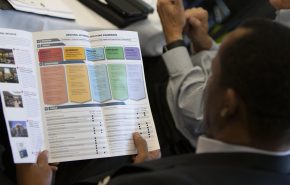Guest blogger economist Owen Beitsch, PhD, FAICP, CRE, senior director with GAI’s Community Solutions Group (CSG), shares informed insight into the pandemic’s effect on the U.S. jobs picture and consumer spending, and an assessment of proposed federal relief measures.
It’s now January 2021, and there are several important numbers to consider as we look back over the past year and forward to the coming year.
In April 2020, the national unemployment rate reached 14.7%.1 This figure is the highest in the United States since the Depression of the 1930’s, when the unemployment peak hit about 25%.2 With subsequent efforts to reopen an economy that had been negatively affected by COVID-19 restrictions, April’s record unemployment level has started to decline.
The calculated rate, of course, is only a momentary measure of work activity, saying nothing about work’s status as full- or part-time, permanence, or alignment to skills. It is only an incidental measure of the number of businesses temporarily or permanently closed. The figure says nothing about the way we conduct work or economic activities. While it says nothing about the cultural ties that were already fraying between worker and employer, it may indicate something about the ways we will work in the future.
To their credit, many employers went as far as they could to maintain benefits and hold positions for employees initially furloughed and not formally dismissed. The financial stress made those arrangements impossible to continue, however. Now those companies will be doubly challenged to rebuild both their labor force and their businesses.
Year-End Unemployment Picture in Human Terms
At the end of December 2020, the ranks of the unemployed fell to about 6.7%,3 the same rate as November and about half the April peak. Yet this improvement in terms of percentage glosses over the enormity of the numbers of affected workers: approximately 11,000,0004 people in a population of approximately 330,000,000 remained out of work in the middle of winter.
Sometimes the actual numbers paint a more informative picture than the percentages. At the April peak of unemployment, about 23,000,000 people, or about 7.0%5 of the American total population, were out of work. Compare that to the 1933 peak number of about 15,000,0006 people unemployed.
Although the rate of unemployment held steady in the last two months of 2020, the Bureau of Labor Statistics (BLS) reports that non-farm unemployment showed a decline of some 140,0007 jobs. The decline is attributable to employers responding to efforts to contain COVID-19 cases in their respective work settings.
BLS reports the intuitive and very visible job losses experienced in the leisure and hospitality and in private education sectors were partially offset by gains in professional and business services, retail trade, transportation, warehousing, and construction.
Consumer Behavior, Retail, Housing, and Earnings
December delivered job gains in almost every retail category. Job counts were up in retailers offering both durable [cars, appliances, furniture] and nondurable [clothing, food] goods.8 Optimistically, the actual level of retail sales for December will validate these gains in employment. However, much of that retail activity is likely to have occurred online at the expense of traditional retail environments, noting that several thousand retail units have closed in the last couple of years even as related employment gained. The shuttered retail businesses are not exclusively business traumas induced by COVID-19. They are an emergent trend exposed and hastened by COVID-19.
![]()
Similarly, these shifts in consumer behavior parallel the employment gains in warehousing and storage, the logistic sectors linked to online channels. Anecdotally, from a number of sources, housing construction remains an extremely bright spot, with strong residential sales expected over the next 18 months. Automobile sales are off, but probably much less than intuitive, having taken a big jump in the latter part of 2020. Americans still purchased about 14,000,000 cars9 in 2020, clearing dealer inventories. As with homes, it is not a buyer’s market.
Astonishingly, those working still employed in January 2020 are receiving modestly higher hourly earnings. Despite this incidental observation, it should be evident that the loss of work over the course of 2020 has had the most adverse effect on women, minorities, and the least educated. These classes have especially disproportionate representation in the food service as well as leisure and hospitality fields. According to the Federal Reserve, unemployment is about 20% for the nation’s lowest-paid workers. The economic landscape is not at all even in its disadvantage.
Precisely how this employment dislocation will affect the economy is speculative and open to very different points of view. Most observers agree the first half of 2021 will have very slow, if any, growth. Many believe that the latter half of the year will spur gains, primarily because of increased vaccination coverage and improved confidence stemming from COVID-19 protection. Spending then will grow. I ascribe to both views.
Bold Government Spending May Build a Path to Recovery
Adding confidence, newly elected President Joseph R. Biden, Jr. proposed a broad stimulus package on January 14, 2021, that was almost impossible to envision in November 2020 when the House and Senate were controlled by different political parties. While shared congressional power offers certain political protections, it has proven a demonstrable deterrent to the ambitious spending the economy seems to need now.
As outlined, Biden’s package would support wider COVID-19 testing, more intensive vaccine production, and accelerated distribution of vaccines, all of which will form the basis for long-term economic recovery. Additionally, Biden has proposed increased direct relief payments for individuals as well as an extension of unemployment benefits, strengthening the social net that unraveled in many states in October and November of 2020.
Biden’s rapidly deployed health care and basic income protections will be paired with infrastructure spending. This combined social and physical strategy offers some assurances that longer-term capital investment activity will follow the burst of stimulus monies and continue the positive economic momentum. While there may be some pressures to take action through tax policy, dollars placed directly in the hands of individuals spread much more quickly into an economy dependent upon consumer behavior.
Given the changes in congressional composition that mark the pathway for upped expenditures, it is not altogether surprising that both bond yields and equity prices moved in early January. Make no mistake: all of these initiatives will prompt heavy government borrowing. This spending will be reflected, at the very least, in an increase of the national debt, now at about $27 trillion, in the immediate term.
Classical Keynesian theory suggests the decision to spend lavishly today will drive substantive economic and fiscal impacts over the intermediate and longer terms to keep gross domestic product in sync with national debt. Record low interest rates service that debt.
I stand with Keynes: I am betting that the increased government spending we can expect to see will have long-term positive effect on the post-COVID-19 U.S. economy.
More insights from Owen Beitsch, PhD, FAICP, CRE:
- How COVID-19 Impacts Property Taxes that Fuel Local Governments (December 2020)
- Weighing In On Central Florida Housing Woes (June 2019)
- Central Florida Housing Report Pinpoints Issues & Opportunities (September 2018)
- 12 Qualities That Drive Successful Community Development (March 2018)
- Top Issues Affecting Real Estate (August 2017)
Contact Senior Director Owen Beitsch, PhD, FAICP, CRE, 321.319.3131, for more information about the GAI Community Solutions Group’s urban planning, economics, and strategy services. Message GAI online and start the conversation about how our multidiscipline professionals can meet your unique project needs.
![]() Owen Beitsch, PhD, FAICP, CRE has been active in the management and execution of complex studies for public and private clients for many years. His particular interest in special issues confronting urban areas is demonstrated in both his civic and business activities. A member of The Counselors of Real Estate and a Fellow in the American Institute of Certified Planners, Owen concluded several years of service as a member of the Orlando Housing Board of Commissioners. Owen is a faculty member in the urban and regional planning program at the University of Central Florida.
Owen Beitsch, PhD, FAICP, CRE has been active in the management and execution of complex studies for public and private clients for many years. His particular interest in special issues confronting urban areas is demonstrated in both his civic and business activities. A member of The Counselors of Real Estate and a Fellow in the American Institute of Certified Planners, Owen concluded several years of service as a member of the Orlando Housing Board of Commissioners. Owen is a faculty member in the urban and regional planning program at the University of Central Florida.
1 https://www.cnn.com/2020/05/08/economy/april-jobs-report-2020-coronavirus/index.html
2 https://www.thebalance.com/unemployment-rate-by-year-3305506
3 https://www.bls.gov/news.release/pdf/empsit.pdf
4 https://tradingeconomics.com/united-states/unemployed-persons
5 https://www.bls.gov/news.release/pdf/empsit.pdf
6 https://www.history.com/topics/great-depression/great-depression-history
7 https://www.bls.gov/news.release/pdf/empsit.pdf
8 https://www.bls.gov/news.release/pdf/empsit.pdf
9 https://www.caranddriver.com/news/a35130259/new-car-sales-end-2020-announced


